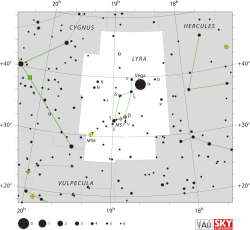HD 168009
| HD 168009 | |
 | |
| Observationsdata Epok: J2000.0 | |
|---|---|
| Stjärnbild | Lyran |
| Rektascension | 18t 15m 32,4634s[1] |
| Deklination | +45° 12′ 33,541″[1] |
| Skenbar magnitud () | +6,307 (V)[2] |
| Stjärntyp | |
| Spektraltyp | G1 V[3] |
| U–B | 0,115[2] |
| B–V | 0,635[2] |
| Astrometri | |
| Radialhastighet () | -64,9 ± 0,1[4] km/s |
| Egenrörelse (µ) | RA: -77,288[1] mas/år Dek.: -114,757[1] mas/år |
| Parallax () | 42,93 ± 0,22[1] |
| Avstånd | 76,0 ± 0,4 lå (23,3 ± 0,1 pc) |
| Absolut magnitud () | 4,52[2][5] |
| Detaljer | |
| Massa | 0,99[4] M☉ |
| Radie | 1,14 ± 0,04[6] R☉ |
| Luminositet | 1,43[7] L☉ |
| Temperatur | 5 792 ± 80[4] K |
| Metallicitet | -0,02 (Fe/H)[4] dex |
| Vinkelhastighet | 3[5] km/s |
| Ålder | 8,1[4] miljarder år |
| Andra beteckningar | |
| HD 168009, AG+45 1429, BD+45 2684, GJ 708.4, GJ 9622, GSC 03525-00186, HIC 89474, HIP 89474, HR 6847, IRAS 18140+4511, 2MASS J18153245+4512333, PLX 4198, PPM 56950, SAO 47343, TD1 22094, TYC 3525-186-1, uvby98 100168009, WISEA J181532.37+451232.3, Gaia DR2 2115351387048328832, Gaia DR1 2115351382751264512 [8][9] | |
HD 168009 är en ensam stjärna[1] belägen i den norra delen av stjärnbilden Lyran. Den har en skenbar magnitud av ca 6,31[2] och kräver åtminstone en handkikare för att kunna observeras. Baserat på parallax enligt Gaia Data Release 2 på ca 42,9[1] mas, beräknas den befinna sig på ett avstånd på ca 76 ljusår (ca 23 parsek) från solen. Den rör sig närmare solen med en heliocentrisk radialhastighet på ca -65 km/s[4] och beräknas komma att ligga på ett avstånd av ca 17 ljusår från solen om ca 328 000 år.[10]
Egenskaper[redigera | redigera wikitext]
HD 168009 är en gul till vit stjärna i huvudserien av spektralklass G1 V,[3] som har en låg nivå på kromosfärisk aktivitet, vilket gör den till en kandidat för en Maunder-minimihändelse.[4] Den har en massa som är ungefär lika med en[4] solmassa, en radie som är ca 1,14[6] solradier och har ca 1,4 gånger solens utstrålning av energi[7] från dess fotosfär vid en effektiv temperatur av ca 5 800 K.[4] Den är en solliknande stjärna och har undersökts med avseende på överskott av infraröd strålning, som kan ange närvaro av en omgivande stoftskiva, men inget statistiskt signifikant överskott har upptäckts.[11][12]
Referenser[redigera | redigera wikitext]
- Den här artikeln är helt eller delvis baserad på material från engelskspråkiga Wikipedia, HD 168009, 25 september 2020.
Noter[redigera | redigera wikitext]
- ^ [a b c d e f g] Gaia Collaboration; et al. (2016), "Gaia Data Release 1. Summary of the astrometric, photometric, and survey properties", Astronomy & Astrophysics, 595: A2, arXiv:1609.04172, Bibcode:2016A&A...595A...2G, doi:10.1051/0004-6361/201629512.
- ^ [a b c d e] Soubiran, C.; Triaud, A. (May 2004), "The Top Ten solar analogs in the ELODIE library", Astronomy and Astrophysics, 418: 1089−1100, arXiv:astro-ph/0402094, Bibcode:2004A&A...418.1089S, doi:10.1051/0004-6361:20035708.
- ^ [a b] Mahdi, D.; et al. (March 2016), "Solar twins in the ELODIE archive", Astronomy & Astrophysics, 587: 9, arXiv:1601.01599, Bibcode:2016A&A...587A.131M, doi:10.1051/0004-6361/201527472, A131.
- ^ [a b c d e f g h i] Lubin, Dan; et al. (March 2012), "Frequency of Maunder Minimum Events in Solar-type Stars Inferred from Activity and Metallicity Observations", The Astrophysical Journal Letters, 747 (2): 6, Bibcode:2012ApJ...747L..32L, doi:10.1088/2041-8205/747/2/L32, L32.
- ^ [a b] Takeda, Yoichi; et al. (February 2005), "High-Dispersion Spectra Collection of Nearby F--K Stars at Okayama Astrophysical Observatory: A Basis for Spectroscopic Abundance Standards", Publications of the Astronomical Society of Japan, 57 (1): 13–25, Bibcode:2005PASJ...57...13T, doi:10.1093/pasj/57.1.13.
- ^ [a b] Fuhrmann, Klaus (July 2011), "Nearby stars of the Galactic disc and halo - V", Monthly Notices of the Royal Astronomical Society, 414 (4): 2893−2922, Bibcode:2011MNRAS.414.2893F, doi:10.1111/j.1365-2966.2011.18476.x.
- ^ [a b] McDonald, I.; et al. (2012), "Fundamental parameters and infrared excesses of Hipparcos stars", Monthly Notices of the Royal Astronomical Society, 427: 343, arXiv:1208.2037, Bibcode:2012MNRAS.427..343M, doi:10.1111/j.1365-2966.2012.21873.x.
- ^ http://simbad.u-strasbg.fr/simbad/sim-id?Ident=HD+168009. Hämtad 2020-09-25.
- ^ "HD 168009". SIMBAD. Centre de données astronomiques de Strasbourg. Hämtad 2018-01-18.
- ^ Bailer-Jones, C. A. L. (March 2015), "Close encounters of the stellar kind", Astronomy & Astrophysics, 575: 13, arXiv:1412.3648, Bibcode:2015A&A...575A..35B, doi:10.1051/0004-6361/201425221, A35.
- ^ Sierchio, J. M.; et al. (April 2014), "The Decay of Debris Disks around Solar-type Stars", The Astrophysical Journal, 785 (1): 13, arXiv:1402.6308, Bibcode:2014ApJ...785...33S, doi:10.1088/0004-637X/785/1/33, 33.
- ^ Ballering, Nicholas P.; et al. (September 2013), "A Trend between Cold Debris Disk Temperature and Stellar Type: Implications for the Formation and Evolution of Wide-orbit Planets", The Astrophysical Journal, 775 (1): 14, arXiv:1308.2223, Bibcode:2013ApJ...775...55B, doi:10.1088/0004-637X/775/1/55, 55.





